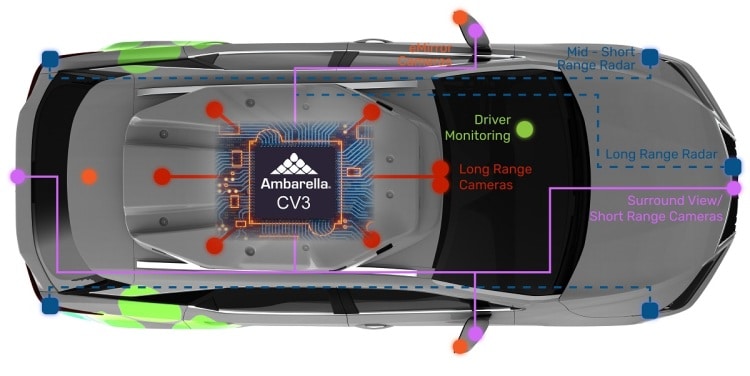Ambarella unveils AI chips for autonomous vehicles at CES 2022
Semiconductor products provider Ambarella has unveiled its new CV3 AI (artificial intelligence) domain controller family during CES 2022.
Part of Ambarella’s scalable and power-efficient CVflow family of SoCs (system on a chip), the new components are designed to provide the automotive industry with high AI processing performance.
The components also enable centralized, single-chip processing for multi-sensor perception, such as high-resolution vision, radar, ultrasonic, and lidar, among others, together with deep fusion for multiple sensor modalities and AV path planning.
According to Ambarella, by using CV3 AI, it is possible to build autonomous driving (AD) systems from basic Advanced Driver Assistance Systems (ADAS) to Level 4 AVs, supporting the full range of viewing, recording, sensing and path planning applications with greater levels of environmental perception, particularly in challenging lighting, weather, and driving conditions.
Autonomous driving standards. Source: NHTSA
“With our new CV3 AI domain controller family, we are now capable of running the full ADAS and AD stack with a single chip, while providing unprecedented performance and power efficiency,” explained Ambarella CEO Fermi Wang.
The flexibility of the new components means automakers won’t need different software development stacks for their entry-level, mid-range, and premium vehicles, and instead use Ambarella’s unified CVflow platform across all models.
This will not only help save engineering costs but also enable faster responses to market trends.
Featuring up to 16 Arm Cortex-A78AE CPU cores and up to 500 eTOPS, the domain controllers can offer a 42x increase over Ambarella’s prior automotive family, as well as up to a 30x boost in CPU performance over the prior generation in support of autonomous vehicle (AV) software applications.
Ambarella said that the CV3 family’s hardware scalability could also enable automakers to unify their software stacks across their entire retail portfolios while reducing the cost and complexity of software development.
Since it integrates Ambarella’s next-generation ISP, a single CV3 can simultaneously support up to 12 physical or 20 virtual cameras, processing the entire sensor suite by itself.
For context, for typical L2+ deployments, roughly ten cameras, five radar modules, and several ultrasonic sensors are needed.
Finally, the new components are compatible with Ambarella’s flexible CVflow AI platform, which provides customers with several software options from partners, working closely with the company to port and optimize their applications.
“Through enhancements to our on-chip ISP, along with simultaneous radar processing that can take advantage of our Oculii adaptive AI algorithms, Ambarella is helping the automotive industry unlock greater levels of perception accuracy across all environmental conditions to realize the promise of autonomous driving,” Wang concluded.
Ambarella’s AI chips were also integrated into Yandex’s SignalQ2 camera last September, following a strategic partnership between the companies.
Article Topics
Ambarella | autonomous vehicles | computer vision | edge AI | processors




Comments